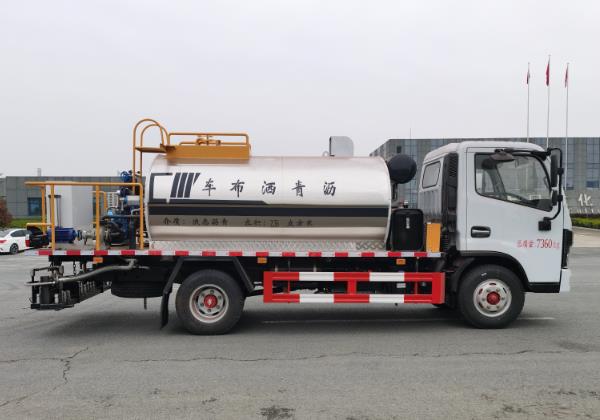Today, with great efforts to build socialism, asphalt spreading trucks play an increasingly important role in the construction of highways, urban roads, airports and port terminals. In today's situation where the machinery industry is developing more and more rapidly, let's take a look at the future development direction of asphalt spreader trucks.


1. Serialization of spreading width;
The general spreading width is from 2.4 to 6m, or wider. Independent or group control of nozzles is a necessary function of modern asphalt spreading trucks. Within the maximum spreading width range, the actual spreading width can be set at any time on site.
2. Tank capacity serialization;
Tank capacity is generally from 1000L to 15000L, or larger. For small maintenance operations, the amount of asphalt is small, and a small-capacity spreader truck can meet the needs; for large-scale highway construction, a large-capacity asphalt spreader truck is needed to reduce the number of times the asphalt spreader truck returns to the warehouse during construction and improve work efficiency.
3. Microcomputerized control;
The driver can complete all settings and operations using a special micro industrial computer in the cab. Through the radar speed measurement system, the spreading amount is proportionally controlled, the spreading is even, and the spreading accuracy can reach 1%; the display screen can display necessary dynamic parameters such as vehicle speed, asphalt pump flow, rotation speed, asphalt temperature, liquid level, etc., so that the driver can be at any time Understand the operation of the equipment.
4. The spreading density expands to both poles;
The spreading density is determined based on the engineering design. For example, as recommended by the National Asphalt Technology Center at Auburn University in the United States, for surface treatment of HMA road maintenance stone chip seals, it is recommended that the asphalt spreading amount can be between 0.15 and 0.5 gallons/square yard depending on the size of the aggregate. (1.05~3.5L/m2). For some modified asphalt with rubber particles, the spreading volume is sometimes required to be as high as 5L/m2, while for some emulsified asphalt as permeable oil, the spreading volume is required to be lower than 0.3L/m2.
5. Improve asphalt heating efficiency and reduce heat loss;
This is a new concept in the design of modern asphalt spreader trucks, which requires lower-temperature asphalt to be quickly heated in the asphalt spreader truck to reach the spraying temperature. To this end, the temperature rise of asphalt should be above 10℃/hour, and the average temperature drop of asphalt should be below 1℃/hour.
6. Improving the starting spreading quality is one of the important performances pursued by asphalt spreading trucks;
Sprinkling quality includes the distance from start to initial spraying and the accuracy of the spraying amount in the initial spraying section (0~3m). Zero spraying distance is difficult to achieve, but reducing the initial spraying distance is beneficial to the continuation of spraying operations. Modern asphalt spreading trucks should keep the spraying distance as short as possible, and spray neatly and in a horizontal line at the beginning.
Henan Sinoroader Heavy Industry Corporation has stable product quality and flexible business methods. The company has taken the lead in fully passing international quality system certification. All its products have passed international compulsory product certification and passed various certifications for export products. We will also continue to improve and innovate based on the performance and quality of asphalt spreading trucks in order to provide better services for road construction and reduce the labor burden of staff.

